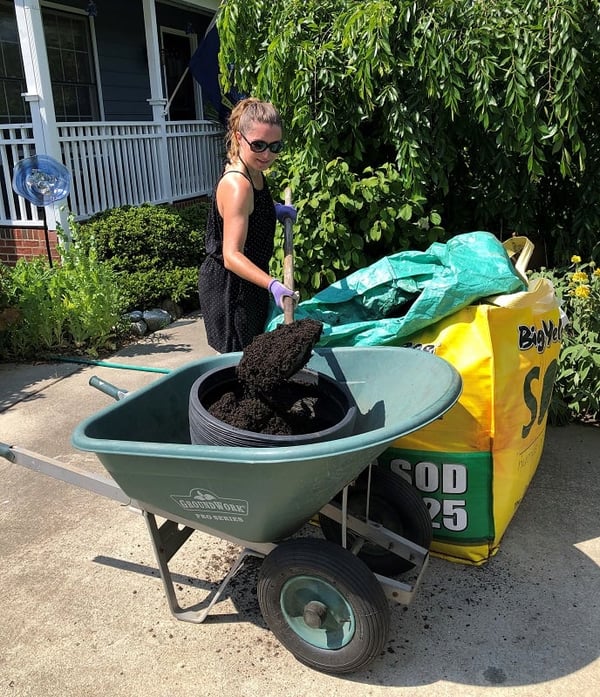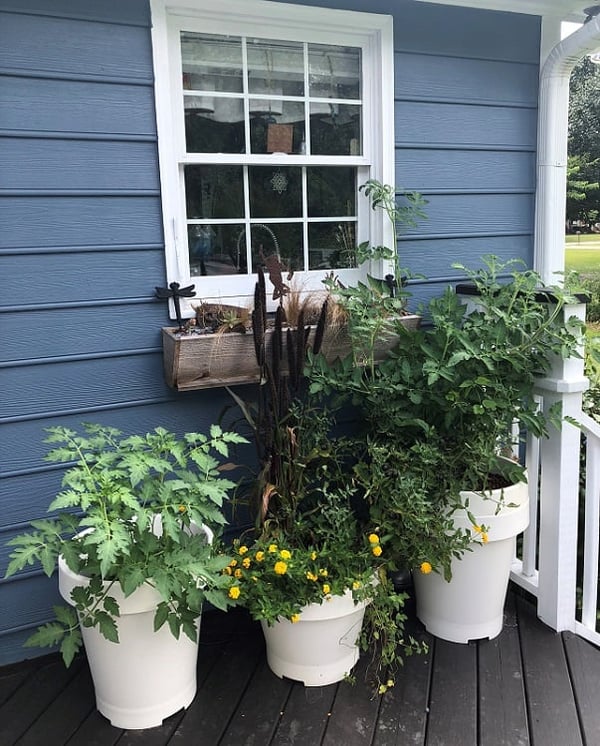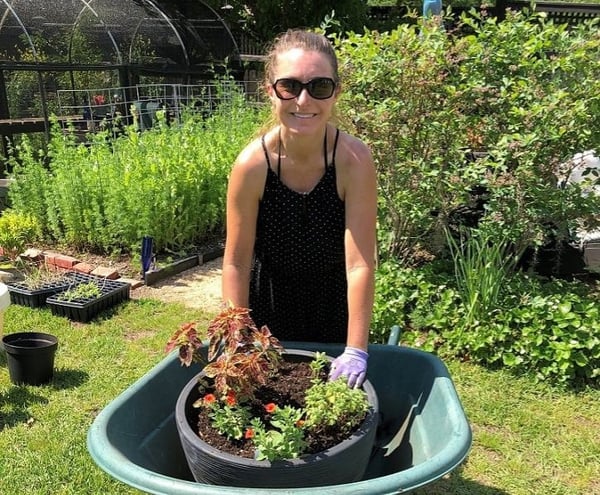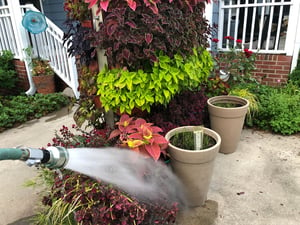Container gardening is for everyone! Brie The Plant Lady is here to share some tips so you can be successful with your containers this summer.
Hi, it’s Brie the plant lady again! It is officially my favorite time of year when the temperatures are warm and all of my favorite plants are growing. From exotic tropical specimens to delicious fruits and vegetables, now is the time to create beautiful and bountiful displays both in the ground and in containers.
 I love to mix various-sized containers filled with flowers, vegetables and vibrant foliage to create interesting garden displays!
I love to mix various-sized containers filled with flowers, vegetables and vibrant foliage to create interesting garden displays!
Container gardening is awesome because the possibilities are endless. You can be creative with your plant selections and pot design. It is a fun way to add interest to patios and porches or spice up a boring spot in your landscape. Container gardening is for everyone, especially when you use Soil³!
 I found that using 100% Soil³ organic humus compost as my growing medium gave the best results for my container gardening.
I found that using 100% Soil³ organic humus compost as my growing medium gave the best results for my container gardening.
Container Basics
When growing plants in containers there are several key things to consider before getting started:
- Pot Selection - Which size and material?
- Location - How much sun or shade? Does it have easy access to water?
- Fertilizer - Synthetic or organic?
- Growing Media - Potting soil or compost?
With thousands of different containers to choose from the hardest part can be pot selection! Consider how heavy the container is empty- then imagine it full of soil. Large pottery is great when sited in a location where they won’t need to be moved. Otherwise look for high quality plastic vessels like the ones sold by Crescent Garden.
I have become a huge fan of this brand because they are stylish and extremely durable. The color does not fade after years in full sun and the plastic does not split in cold temperatures. I also like the water storage capacity these containers offer as it reduces the need for daily irrigation.
 Add interest to your porch with containers. Choose high quality ones that will last several seasons.
Add interest to your porch with containers. Choose high quality ones that will last several seasons.
Other options include grow bags which are light weight and inexpensive. They drain well and are very efficient for summer loving plants, both ornamental and edible. The grow bags may not be “fancy” looking but they are a great way to add plants to decks and patios and can easily be incorporated with other types of containers.
 The beginnings of a bountiful strawberry harvest in our Soil³-filled grow bags last summer.
The beginnings of a bountiful strawberry harvest in our Soil³-filled grow bags last summer.
Location of your containers is the most critical aspect of successful growing. If you are planting sun loving selections, make sure you site them in full sun! This means 6+ hours of bright exposure. For shade combinations place your pots in areas with morning exposure with up to 4 hours of sun.
Fertilizer is an important consideration for container gardening. Unlike growing in the ground where nutrients are available for long durations of time; containers drain quickly and the nutrients leach very quickly. This is why synthetic coated granular fertilizers, such as Osmacote are recommended. Since I am primarily an organic grower, instead I add a handful of Espoma Plant-Tone to the top 6 inches of soil upon planting and then apply fish emulsion once a month. Either way, it is important to provide ample fertility to maximize the plants' development all season.
Selecting the ideal growing media can be really confusing. Even as a professional, I have found myself struggling over the years - until I started using Soil³. For most of my gardening life I used “potting soil” for all of my container plantings. The peat moss-based mix was light and well draining, but required constant watering. Since I do not have an irrigation system, watering the pots through the heat of the summer can become a huge chore.
 Make sure you place containers with vegetables, like these peppers, in sunny spots that are also conveniently close for watering.
Make sure you place containers with vegetables, like these peppers, in sunny spots that are also conveniently close for watering.
Last year I decided to change things up. Since I have been using Soil³ as a compost amendment in my garden beds for years I wondered how it would do as a container mix. I decided to conduct an experiment using different types of containers and different soil mixes and rate the container gardens' performance, durability, and watering requirements.
CONTAINERS PROVIDE SOLUTIONS
Sometimes container gardening is a necessity. For me, I have to grow my favorite summer crop, tomatoes, in containers to avoid the root-knot nematodes lurking in my soil. Instead of giving up, I have reinvented my approach to growing delicious heirloom varieties mixed with colorful flowering plants to increase the wow factor throughout my garden.
 Mix things up! Pair heirloom tomatoes with colorful coleus or sun-loving annual flowers in pretty pots.
Mix things up! Pair heirloom tomatoes with colorful coleus or sun-loving annual flowers in pretty pots.
THE 2018 SOIL³ CONTAINER EXPERIMENT
Container selection was the first thing to address. I used 7 gallon plastic pots, 3 gallon terra cotta vessels, 3 gallon to 7 gallon fabric grow bags, and assorted 3 gallon Rootmaker pots.
I kept the potting media simple with just three variants:
- 100% traditional potting soil
- 50% potting soil and 50% Soil³ organic compost
- 100% Soil3 organic compost
The fertilizer application was the same for everything. At the time of planting I added 1 handful Plant-tone and incorporated it into the top 6” of soil. Once a month I applied fish emulsion as a foliar and root feed.
Sunny locations with easy access to water were selected to ensure the best development of the plants while making it convenient for my husband and me. When pots are located out of sight they can become a chore to manage, so be sure to site your pots in easy to reach places.
THE RESULTS
All of the containers planted with 100% Soil³ organic compost performed best! The plants thrived and produced significant harvests. Most importantly the containers didn’t dry out as quickly as the other two growing medias, which reduced our watering labor significantly.
The types of containers also made a difference. The most successful were the 3 gallon RootBuilder II Pots from RootMaker.
 Our heirloom tomato plants flourished in RootBuilder II Pots filled with Soil³ organic compost - and bore fruit until first frost!
Our heirloom tomato plants flourished in RootBuilder II Pots filled with Soil³ organic compost - and bore fruit until first frost!
The heirloom tomatoes thrived growing 10 foot-plus long vines that produced an abundance of fruit for many months. These plants even survived two fall hurricanes and despite getting a bit wind-whipped they continued to flower and set tomatoes until frost in mid-November.
The fabric bags were a close second for plant performance and ease of watering. Larger bags are best for long season plants with heavy root systems, like tomatoes. The 3 gallon and 7 gallon grow bags are ideal for home gardeners cultivating edible and ornamental container gardens. Because of the white plastic coating on the RootTrapper bags, the plants thrived with cooler root systems.
Traditional containers were not a total bust, and this is where the 100% Soil³ really shined through. The plants growing in 100% potting soil and the 50/50 mix dried out so fast and the plants looked stressed for most of the growing season.

THE 2019 GROWING SEASON
I learned so much last year about how to make container gardening easier for me and I am always so pleased to share practical advice. This year I used Soil³ organic humus compost as my primary gardening media in a range of containers from stylish pots to industrial grow bags. So far everything looks great, especially my beloved heirloom tomatoes.
Stay tuned for updates from me, Brie the plant lady, this summer and I wish you much success with your container gardens!
UPDATE: THE 2022 GROWING SEASON
Since I wrote this, Soil³ created a new blend called Veggie Mix. It's 75% their tried and true compost, with 25% bark blended in. One component of the bark is a product called HydraFiber that's made by heating and pressurizing pine chips into long strands. These strands hold and release water really well and help keep the Veggie Mix moist like the straight compost, while also offering more air pockets for the roots to grow in and better drainage.
I now use Veggie Mix for all my containers and all vegetable plantings.
Happy planting,
Brie










Did this help you out? Have any questions for clarity? Leave a comment below!